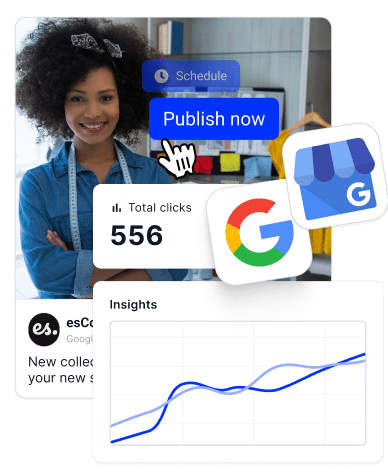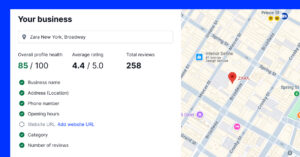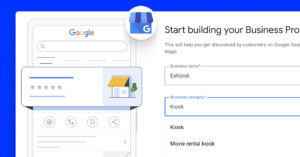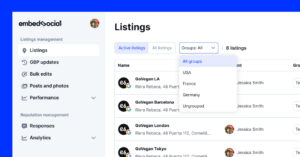Mapping apps aren’t just for finding directions anymore—they’re powerful tools for business discovery, local SEO, and customer trust.
After all, whether someone’s asking Siri or searching on Google, their journey to your storefront often begins on a digital map.
Today, the battle of Apple Maps vs Google Maps is more relevant than ever for businesses that want to stand out—both on the screen and in real life.
So, which one should your business prioritize—and why?
Let’s break it down.
Why mapping apps matter for your business in 2024?
Mapping apps aren’t just navigation tools—they’re critical gateways connecting customers to your business. Here are the reason why they are essential:
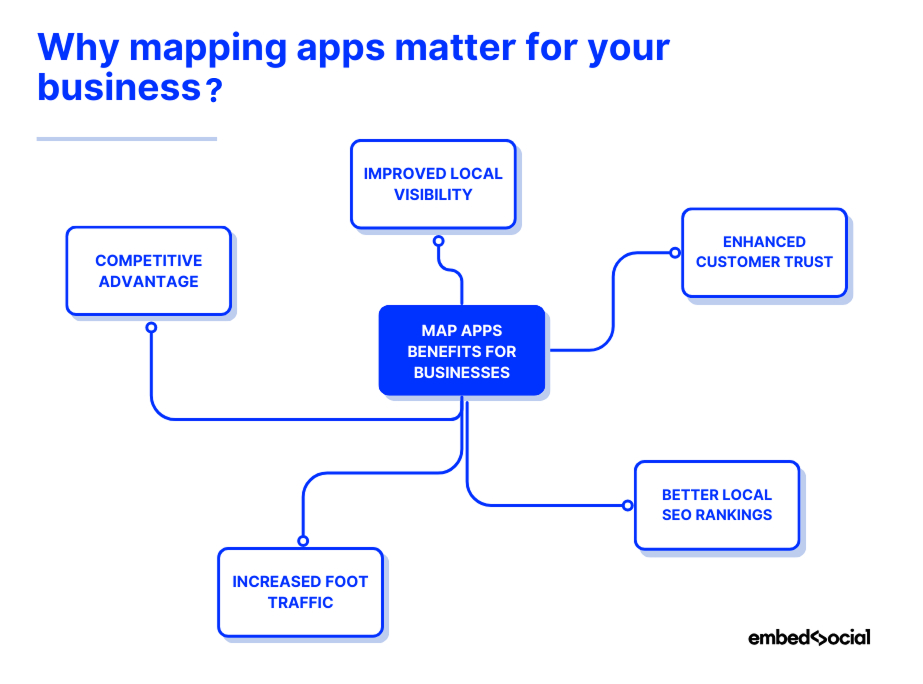
- Improved local visibility—customers find businesses primarily through mobile searches, often directly on maps;
- Enhanced customer trust—accurate listings and positive reviews reassure customers, boosting your credibility;
- Better local SEO rankings—businesses listed on Google Maps benefit from higher visibility in local search results;
- Increased foot traffic—real-time navigation directs customers straight to your doorstep by giving them up-to-date driving or walking directions;
- Competitive advantage—maintaining an active presence ensures your business stands out among competitors.
Optimizing your presence on Apple Maps and Google Maps is now crucial—not optional—for businesses aiming for success in 2024.
Google Maps vs Apple Maps: A quick snapshot for businesses
To quickly understand how each platform could benefit your business, here’s a straightforward comparison between Apple vs Google Maps:
| Feature: | Google Maps | Apple Maps |
|---|---|---|
| Market Reach | Larger global user base, used on Android & iOS | Smaller but growing, used on Apple devices |
| Business Listing Management | Google Business Profile (GBP) with extensive customization | Apple Business Connect with basic features |
| Customer Reviews | Google Reviews with direct business responses | Uses third-party reviews (Yelp, TripAdvisor) |
| SEO & Search Visibility | Appears in Google Search results, high visibility | Limited SEO benefits, not integrated with Google Search |
| Navigation Features | Real-time traffic, alternate routes, street view | Smooth UI, Siri integration, Look Around feature |
| Public Transport Info | Extensive public transit details | Improved transit data but less extensive |
| Offline Maps | Full offline map capabilities | Limited offline capabilities |
| Customer Engagement | Direct customer interaction via messages, posts | Limited engagement, no direct messaging |
| Integration with Other Services | Works with Google Search, Ads, YouTube, etc. | Works with Apple ecosystem (Siri, Apple Pay) |
| Analytics & Insights | Detailed insights on customer interactions & traffic | Minimal analytics, fewer data insights |
Google Maps vs Apple Maps: Customer Discovery Journey
Both Google Maps and Apple Maps offer a streamlined user experience, during which customers search and find your business and set the destination.
Here’s a breakdown of both processes:
Google Maps:
- Search: Customer enters business type or specific new location on Google Search or Google Maps.
- View Profile: Customer sees detailed Google Business Profile with hours, photos, and services.
- Check Reviews: Reads ratings, reviews, and Q&A directly on Google.
- Get Directions: Uses Street View or Immersive View to preview the actual location, and gets real-time directions.
- Visit Location: Customer arrives at the business.
Apple Maps:
- Search: Customer searches via the Apple Maps search bar or asks Siri for recommendations.
- View Profile: Customer sees streamlined Apple Business Connect profile (basic info, photos).
- Check Reviews: Reviews sourced from third-party platforms (Yelp, TripAdvisor).
- Get Directions: Customer gets simple, easy-to-follow directions with Look Around (if available).
- Visit Location: Customer arrives at the business.
Apple Maps vs Google Maps for businesses: Detailed feature comparison
Choosing between Google vs Apple Maps directly impacts the overall performance of your business, and for that reason, I go over their unique benefits below.
Knowing precisely how they differ helps you allocate resources effectively, so keep reading to get an in-depth feature-by-feature of both platforms.
Here’s a brief comparison of the main features of both platforms, but keep on reading, as below I delve into detail as to how they compare against each other:
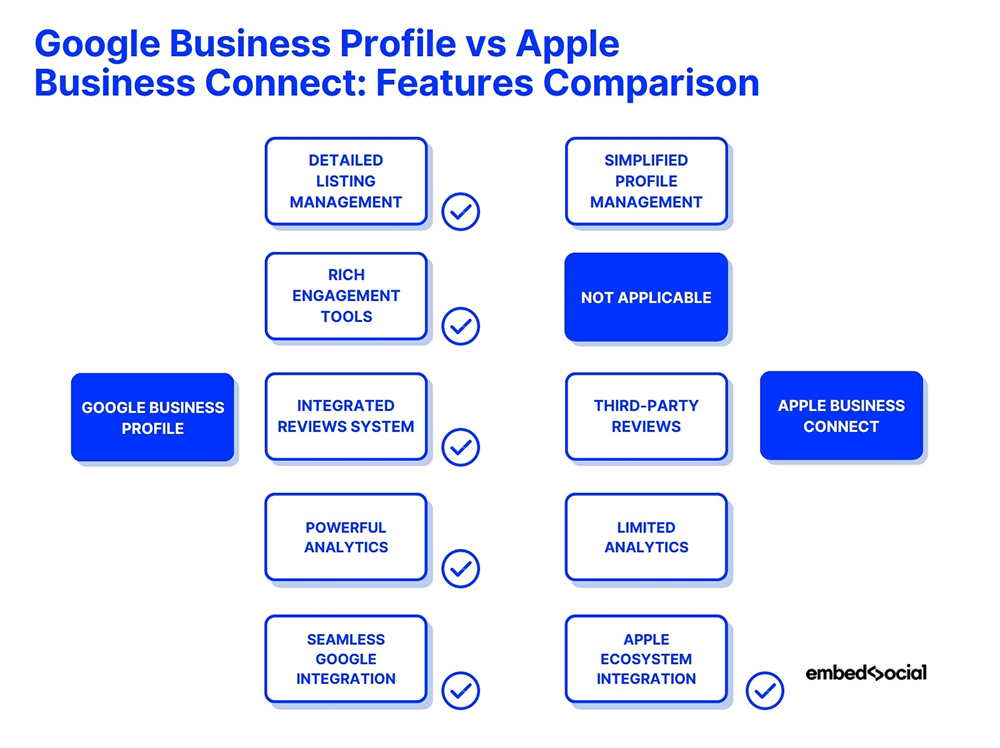
1. Market reach and audience segmentation
Before doing anything else, you must understand the apps’ market reach so you can strategically choose between Google vs Apple maps.
Google Maps: for maximum reach
- More than a billion people use Google Maps every month (Google Cloud).
- Android’s default app (72% global smartphone market share) (Statcounter).
- Crucial for businesses seeking wide visibility across diverse demographics.
“Google Maps remains the gold standard for navigation apps due to its superior directions, real-time data, and various tools for traveling in urban and rural environments.” – PCMag, 2024
Apple Maps: for a targeted, affluent audience
- Pre-installed on approximately 2.35 billion active Apple devices globally (9to5Mac).
- Particularly strong in affluent markets like North America and Western Europe.
- Ideal for businesses targeting Apple’s premium user demographic.
“Apple Maps thrives among affluent Apple users, especially in the United States and Europe.” – Fast Company, 2024
Quick usage comparison (2024):
- Google Maps: Approximately 70% of total mapping app users.
- Apple Maps: Approximately 20-25%, steadily growing in iOS-heavy regions.
Bottom line:
Use Google Maps for maximum global exposure, but Apple Maps is vital for connecting with premium segments in iOS-focused markets. After all, Google Maps offers easy access to every other product in the Google app family, including its extensive reviews.
2. Business profile management and ecosystem integration
How you manage your business profile directly affects your customers’ ability to find, engage with, and trust your business.
Google Maps: Extensive control and integration
Google Maps integrates seamlessly with Google Business Profile (GBP), giving you extensive control over how your business appears online. You can:
- Add detailed business information (hours, contact, accessibility features);
- Optimize your Google Business Profile by uploading photos, videos, and promotional content;
- Directly engage with customers through Google Posts, Q&A, and instant messaging;
- Utilize rich integrations with Google Search, Google Ads, YouTube, and more to streamline your online marketing efforts.
Apple Maps: Simplified but limited ecosystem
With Apple Business Connect, you’ll experience a more streamlined, user-friendly platform—but with fewer features:
- Quickly update basic business info and photos;
- Direct integration with Siri, Apple Calendar, and Apple Wallet, improving convenience for iOS users;
- Limited interactive or promotional capabilities compared to GBP;
- Apple Shortcuts integration allows customers to automate actions easily (e.g., saving parking or favorite locations).
Bottom line:
Google Maps offers more strategic value for businesses requiring deeper customer engagement and robust marketing tools. However, optimizing your presence on Apple Maps remains critical if your customer base relies heavily on Apple devices.
3. Customer reviews and reputation management
You know by now that customer feedback strongly influences your business’s reputation, local rankings, and overall trustworthiness.
Google Maps: Direct reviews, strong influence
Google Maps features integrated Google Reviews, allowing customers to:
- Leave Google star ratings, comments, and photos directly on your profile;
- Ask questions, receive prompt responses, and interact with your business publicly;
- Directly impact your local SEO rankings, visibility, and credibility.
Google’s system also lets you directly manage and respond to Google reviews, significantly enhancing your customer engagement.
Apple Maps: Reliance on third-party reviews
Apple Maps doesn’t offer native reviews. Instead, it relies on exteустrnal platforms like Yelp and TripAdvisor:
- Reduces direct control, forcing you to do your review management elsewhere;
- Minimizes spam and fake reviews due to third-party moderation;
- Can dilute your direct influence over your business’s reputation management.
Bottom line:
Google Maps provides powerful tools for direct online reputation management and customer interaction. Apple Maps offers simplicity and fewer spam risks, but it requires careful cross-platform review management.
4. Local SEO, visibility, and discoverability
Your business’s visibility on maps directly shapes how easily potential customers can discover you. Naturally, if you can’t be found, you get no business!
Google Maps: Enhanced discoverability through search
Google Maps listings are deeply integrated into Google Search, making your business highly visible to Google Maps users searching locally. Benefits include:
- Improved chances of appearing in Google’s local pack (top local search results);
- Voice search optimization through Google Assistant, improving discoverability through spoken queries;
- Advanced SEO features within Google Business Profile help you strategically target customers.
Apple Maps: Ecosystem-driven visibility
Apple Maps isn’t directly integrated with Google Search, relying instead on Siri and the broader Apple ecosystem for discoverability:
- Visibility primarily depends on Apple’s own devices (Siri searches, calendar integration);
- More limited opportunities for traditional SEO optimization;
- Essential for businesses targeting users heavily invested in the Apple ecosystem.
Bottom line:
Google Maps is the clear choice for broad SEO visibility and discovery, while Apple Maps is valuable for reaching dedicated Apple users who primarily rely on Siri and Apple-native apps.
5. Visual presentation and brand visibility
How your business visually appears on mapping platforms shapes customers’ perceptions of your brand and location. Here’s what both maps look like:
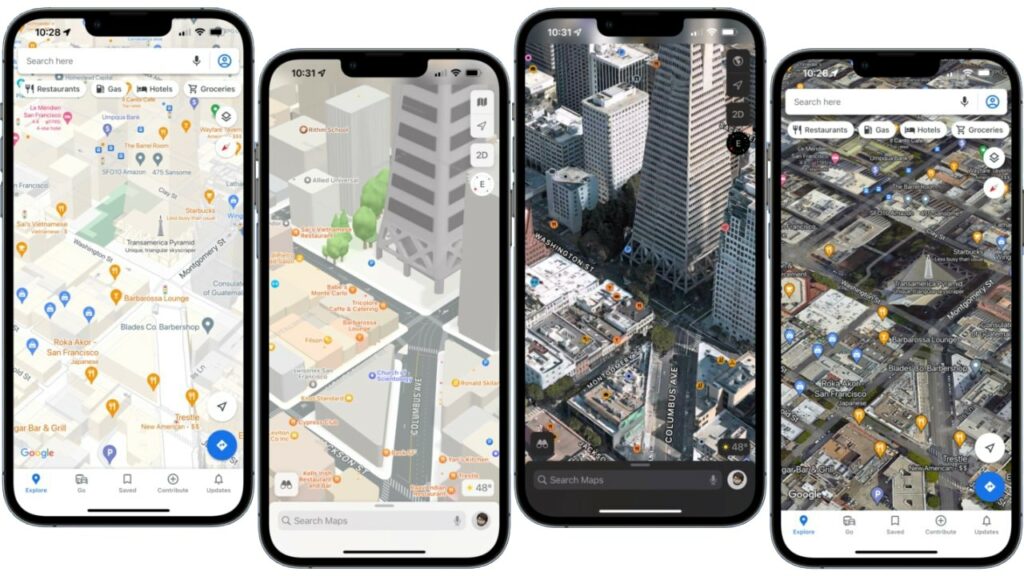
Google Maps: Immersive visuals and rich detail
Google Maps provides robust visual tools to enhance your brand’s presence:
- Google’s Street View: Lets customers virtually visit your location beforehand; for instance, they can view your coffee shops before visiting;
- Immersive View: Offers interactive, realistic 3D visuals for select cities, enhancing trust and attractiveness;
- Rich, detailed local imagery that helps set customer expectations clearly.
Apple Maps: Clean visuals and premium aesthetics
Apple Maps takes a minimalist yet visually appealing approach:
- Look Around: A smooth, visually polished alternative to Street View, though available mainly in major cities;
- Photogrammetry (3D aerial views) enhances presentation in supported regions, meaning all local points will have high-quality images;
- Sleeker UI and fewer distractions, offering your customers a clean, uncluttered map experience.
Bottom line:
Google Maps excels at detailed, immersive visuals, while Apple Maps provides premium aesthetics. Both significantly impact your business’s visual appeal and customer perception.
6. Navigation and customer experience
Easy, reliable navigation directly affects whether customers choose your business over competitors.
Google Maps: Comprehensive navigation options
Google Maps offers advanced, feature-rich navigation, including:
- Clear and detailed turn-by-turn directions;
- Extensive real-time traffic data collection and alternate route suggestions;
- Multi-stop routing, optimizing customer journeys;
- Detailed public transport integration, assisting customers in reaching you efficiently.
Apple Maps: Smooth, user-friendly navigation
Apple Maps emphasizes clarity, simplicity, and convenience:
- Natural language turn-by-turn directions (e.g., “turn after the next traffic light”);
- Seamless integration with Apple ecosystem (Apple Pay, Wallet, Calendar);
- Improved real-time traffic data, though still slightly behind Google in comprehensiveness;
- Dark mode and a refined UI enhance readability and user comfort.
Bottom line:
Google Maps offers powerful navigation tools for broader customer needs. Apple Maps delivers refined, easy-to-follow directions ideal for Apple ecosystem users.
7. Analytics, insights, and performance tracking
Data-driven decisions empower your business growth and efficiency, making analytics crucial.
Google Maps: Rich, actionable insights
Google Maps (via Google Business Profile) provides detailed, actionable insights:
- Track customer interactions (clicks, calls, bookings, directions requests);
- Understand customer search behavior and trends;
- Easily measure marketing efforts through direct metrics and reporting tools.
Apple Maps: Limited analytics, simpler approach
Apple Maps currently provides limited analytics capabilities:
- Basic insights on searches and map views;
- No detailed engagement metrics or deep audience analytics;
- Simplified dashboard suitable primarily for basic listing management.
Bottom line:
Google Maps is the superior choice for comprehensive analytics and strategic insights, essential for detailed performance tracking and growth strategies. Apple Maps offers limited data that is suitable mainly for businesses that need only basic information.
Conclusion: Optimize your listings for both map apps!
Choosing between Google Maps vs Apple Maps ultimately depends on your business audience, goals, priorities, and, of course, your resources.
You don’t have to care about how many people use Apple Maps vs Google Maps, but what’s right for your business.
Here’s a simple decision tree to help you make the right choice:
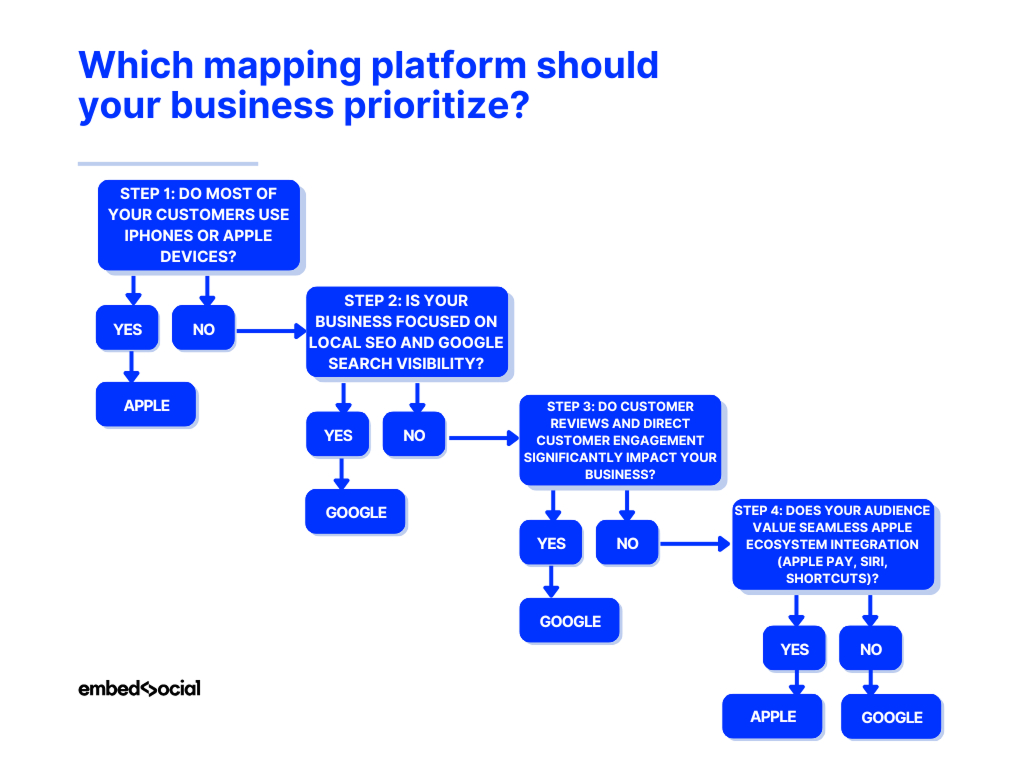
If maximum reach, robust analytics, direct customer engagement, and local SEO visibility are your main goals, Google Maps is clearly the stronger option.
It’s indispensable for businesses aiming for widespread visibility and consistent customer interaction.
However, Apple Maps shouldn’t be overlooked, especially if your customers primarily use Apple devices. Businesses that target iPhone users can benefit from seamless integration within Apple’s ecosystem and a streamlined user experience.
For best results, optimize your listings on both platforms—this strategy ensures comprehensive coverage and maximum discoverability for your business in 2024.
FAQs about Apple Maps vs Google Maps
What is the most accurate map app?
When comparing Apple Maps vs Google Maps in 2025, you’ll find out that both platforms are highly accurate. However, Google Maps generally has a slight edge globally, especially outside urban areas.
What is the advantage of Apple Maps?
In the Apple vs Google Maps debate, Apple Maps excels with its seamless Apple ecosystem integration, privacy-oriented features, and user-friendly interface tailored specifically for Apple device users.
Why choose Google Maps over Apple Maps?
Businesses often prefer Google Maps over Apple Maps for its extensive global reach, superior SEO visibility, direct customer engagement, and detailed business insights through Google Business Profile.
Does Apple Maps have real-time traffic?
Yes, Apple Maps provides real-time traffic information. However, comparing Google Maps vs Apple Maps, Google tends to offer more detailed updates and alternative route suggestions.
Which one is better for customer reviews?
In the question of Google Maps vs Apple Maps which is better for online reviews, Google Maps clearly leads, enabling businesses to directly engage customers through integrated reviews and interactions.
Do more people use Apple Maps or Google Maps?
When considering how many people use Google Maps vs Apple Maps, Google Maps dominates with a significantly larger global user base, driven by its popularity on Android and widespread use on iOS.
